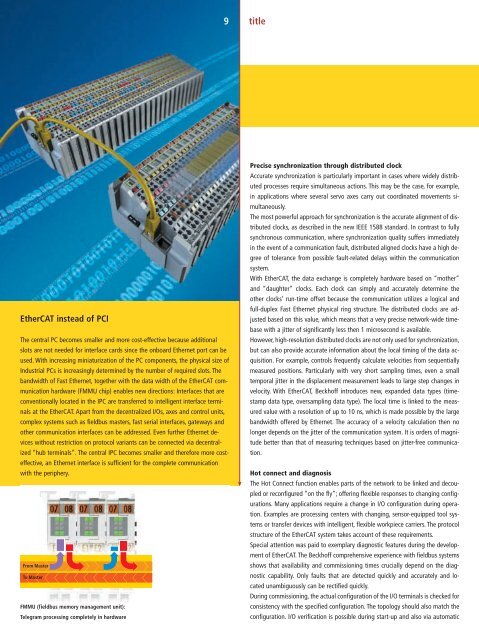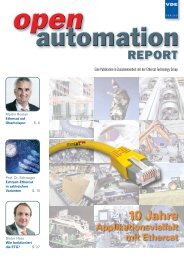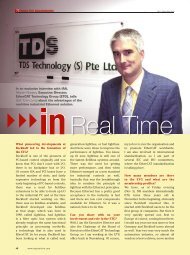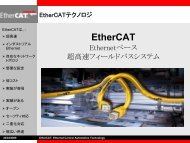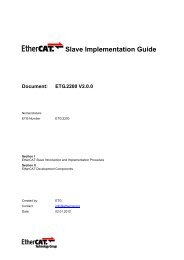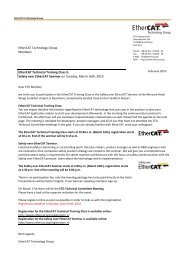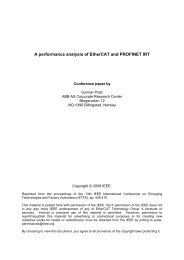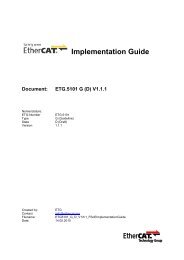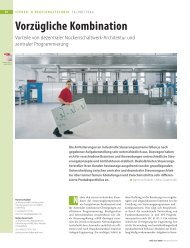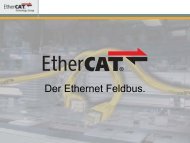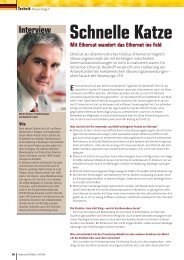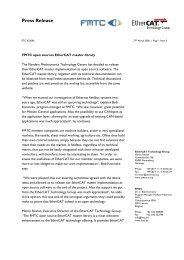06/2003 - EtherCAT
06/2003 - EtherCAT
06/2003 - EtherCAT
Create successful ePaper yourself
Turn your PDF publications into a flip-book with our unique Google optimized e-Paper software.
<strong>EtherCAT</strong> instead of PCI<br />
The central PC becomes smaller and more cost-effective because additional<br />
slots are not needed for interface cards since the onboard Ethernet port can be<br />
used. With increasing miniaturization of the PC components, the physical size of<br />
Industrial PCs is increasingly determined by the number of required slots. The<br />
bandwidth of Fast Ethernet, together with the data width of the <strong>EtherCAT</strong> communication<br />
hardware (FMMU chip) enables new directions: Interfaces that are<br />
conventionally located in the IPC are transferred to intelligent interface terminals<br />
at the <strong>EtherCAT</strong>. Apart from the decentralized I/Os, axes and control units,<br />
complex systems such as fieldbus masters, fast serial interfaces, gateways and<br />
other communication interfaces can be addressed. Even further Ethernet devices<br />
without restriction on protocol variants can be connected via decentralized<br />
“hub terminals”. The central IPC becomes smaller and therefore more costeffective,<br />
an Ethernet interface is sufficient for the complete communication<br />
with the periphery.<br />
From Master<br />
To Master<br />
FMMU (fieldbus memory management unit):<br />
Telegram processing completely in hardware<br />
9 title<br />
Precise synchronization through distributed clock<br />
Accurate synchronization is particularly important in cases where widely distributed<br />
processes require simultaneous actions. This may be the case, for example,<br />
in applications where several servo axes carry out coordinated movements simultaneously.<br />
The most powerful approach for synchronization is the accurate alignment of distributed<br />
clocks, as described in the new IEEE 1588 standard. In contrast to fully<br />
synchronous communication, where synchronization quality suffers immediately<br />
in the event of a communication fault, distributed aligned clocks have a high degree<br />
of tolerance from possible fault-related delays within the communication<br />
system.<br />
With <strong>EtherCAT</strong>, the data exchange is completely hardware based on “mother”<br />
and “daughter” clocks. Each clock can simply and accurately determine the<br />
other clocks’ run-time offset because the communication utilizes a logical and<br />
full-duplex Fast Ethernet physical ring structure. The distributed clocks are adjusted<br />
based on this value, which means that a very precise network-wide timebase<br />
with a jitter of significantly less then 1 microsecond is available.<br />
However, high-resolution distributed clocks are not only used for synchronization,<br />
but can also provide accurate information about the local timing of the data acquisition.<br />
For example, controls frequently calculate velocities from sequentially<br />
measured positions. Particularly with very short sampling times, even a small<br />
temporal jitter in the displacement measurement leads to large step changes in<br />
velocity. With <strong>EtherCAT</strong>, Beckhoff introduces new, expanded data types (timestamp<br />
data type, oversampling data type). The local time is linked to the measured<br />
value with a resolution of up to 10 ns, which is made possible by the large<br />
bandwidth offered by Ethernet. The accuracy of a velocity calculation then no<br />
longer depends on the jitter of the communication system. It is orders of magnitude<br />
better than that of measuring techniques based on jitter-free communication.<br />
Hot connect and diagnosis<br />
The Hot Connect function enables parts of the network to be linked and decoupled<br />
or reconfigured “on the fly”; offering flexible responses to changing configurations.<br />
Many applications require a change in I/O configuration during operation.<br />
Examples are processing centers with changing, sensor-equipped tool systems<br />
or transfer devices with intelligent, flexible workpiece carriers. The protocol<br />
structure of the <strong>EtherCAT</strong> system takes account of these requirements.<br />
Special attention was paid to exemplary diagnostic features during the development<br />
of <strong>EtherCAT</strong>. The Beckhoff comprehensive experience with fieldbus systems<br />
shows that availability and commissioning times crucially depend on the diagnostic<br />
capability. Only faults that are detected quickly and accurately and located<br />
unambiguously can be rectified quickly.<br />
During commissioning, the actual configuration of the I/O terminals is checked for<br />
consistency with the specified configuration. The topology should also match the<br />
configuration. I/O verification is possible during start-up and also via automatic


